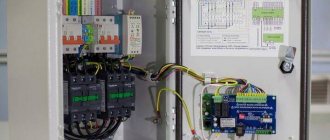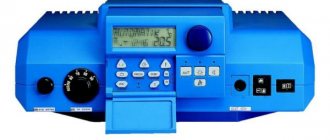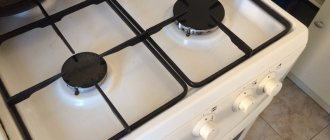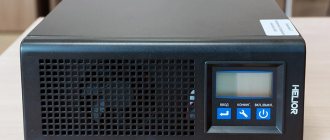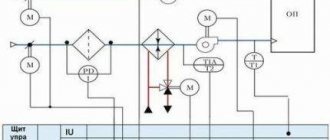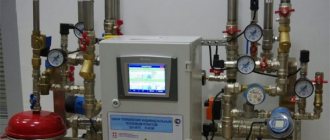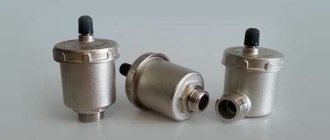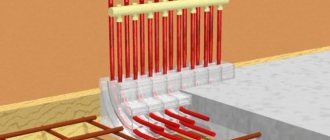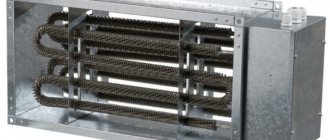- Automation of ventilation systems
- Control panels
- Shield device
- Building an automated system
- Defense system
- Control cabinet arrangement diagram
- How to place control panels?
- Benefits of professional installation
Send a request by email or call +7 (499) 113-68-14, and our engineer will prepare you our commercial offer.
The ventilation system is one of the main components of any room. The microclimate and, accordingly, a person’s comfortable stay at home or at work depend on it. A ventilation control panel is a device that allows centralized control of absolutely all components of an automatic ventilation control system.
Unfortunately, most of us have the habit of not paying any attention to the quality of room ventilation. However, in countries with the most developed economies, ventilation and air conditioning mechanisms have already become a major necessity for ensuring human health.
What is automation for ventilation systems
Today, automatic ventilation control systems are represented by a large complex of various technical devices. All of them, from thermostats to complex computerized modules, are designed to facilitate the management and control of the operation of forced ventilation systems. The variety of equipment makes it possible to solve automation problems at any facility, regardless of its characteristics and purpose.
Based on operational and technical requirements, different approaches to the manufacture of automated ventilation control panels are possible:
- At some facilities, you can get by with standard modules produced in the form of cabinets with control devices installed in them.
- In other cases, installers have to manually assemble complexes adapted for complex supply and exhaust ventilation systems, taking into account specific tasks.
The difference in approaches is due to the need to ensure effective ventilation and create comfortable conditions for residents or workers in the interior of the building, regardless of the time of year and external weather conditions.
Important! In large shopping and entertainment complexes, in educational and administrative buildings, in large industries, the installation of equipment for automation of ventilation systems allows you to eliminate possible operational failures and minimize the influence of the human factor.
The operation of ventilation mechanisms is controlled using a set of sensors installed indoors. Some of them operate on the principle of a thermostat - as the temperature inside the building rises, fans automatically turn on, thereby ensuring a flow of fresh air.
We recommend that you read: Recirculating kitchen hood without duct
Modern automated systems are equipped with elements of artificial intelligence and more complex instrumentation.
Structurally, similar modules consist of three groups of nodes:
- Sensors are devices that transmit information about the environment - thermostats, air humidity meters, gas analyzers. They transmit the collected data to the analyzing center.
- The control center collects and processes information coming from control sensors and, based on the analysis obtained, issues commands to control mechanisms to change the operating mode.
- Actuators are units that perform mechanical actions. This group includes: fan speed converter, servo drives for adjusting the position of valves, etc.
Control centers analyze the ratio of oxygen and carbon dioxide in the air, the percentage of humidity, and, if necessary, issue a command to ventilate the room. When a fire is detected, highly intelligent electronics independently block the flow of fresh air, preventing the spread of fire.
In normal mode, automation ensures the smooth functioning of all components and mechanisms of ventilation systems without the involvement of an operator.
Computerized modules transmit information about the operating mode and sensor readings to a single control panel. This allows the operator, if necessary, to adjust the operation of the automation and change settings remotely.
Note! Thanks to the use of automation, a much smaller number of technical specialists can control the operation and maintain ventilation with installed automation.
Depending on the specific situation, one of 3 device control modes is used:
- Manual. Ventilation control is carried out by an operator located directly in the control room or at a remote control panel.
- Autonomous. The equipment operates in accordance with the established settings, regardless of other engineering systems installed in the building.
- Auto. Control devices are integrated into the overall control of all engineering complexes of the building. The ventilation operation is synchronized with other devices and sensors located in the house - for example, with a fire alarm and other emergency sensors.
Thus, the automated complex plays the role of a control center. It starts the ventilation, stops it, processes sensor readings and sets the desired mode depending on temperature, humidity and other parameters.
Purpose of the ventilation control panel
If it is necessary to turn on or configure a household split system or supply ventilation devices fixed in the ventilation duct opening, then no control units are required - each device is adjusted manually or from the remote control.
But if the length of the networks is large, and the devices are installed in inaccessible places: in shafts, on the roof or attic, in specially designed niches inside the walls, then it becomes necessary to install a remote control unit.
All information about the operation of air heaters, convectors, and individual fans goes to a single center - SHCHUV. Automatic machines responsible for the operation and adjustment of devices are also located here.
Modern control panels are panels with indicator control devices or metal cabinets that are installed on the floor or suspended from the wall. To protect the internal contents, there are hinged doors that can be locked. In addition to the abbreviation SHUV, you can also find SHUV (cabinet).
Main functions of the SHCHUV:
- control over equipment included in ventilation and air conditioning systems;
- protection of units from overheating, incorrect installation and connection, short circuit;
- adjustment of the most important equipment parameters, such as productivity or power;
- programming the operation of the entire system or individual units for a given time period - day, week, month;
- providing an indication that facilitates monitoring and adjustment;
- maintaining a certain temperature in various rooms, the ability to quickly change its parameters;
- control over the internal walls of air ducts and the degree of filter contamination;
- preventing failures in the operation of seasonally dependent equipment, for example, water heaters, which can freeze at too low temperatures.
Installing an electrical panel at an enterprise or in a residential building allows maintenance personnel to monitor the operation of equipment from one place and quickly respond to breakdowns and shutdowns of individual devices. Devices that control fire extinguishing and partial heating devices can also be located in the same cabinet.

SHUPVV installation diagram. Cabinets can be common, combining all the devices in the building, and serving a separate floor, wing, workshop, section, etc.
If an emergency occurs, for example, a fire in one of the rooms, the ventilation equipment is stopped automatically or manually - from the control panel.
The main tasks of automation for ventilation
Since the modern market offers a large number of various technical devices for ventilation automation, the range of their functions is also extremely wide.
Main functions of the control module equipped with elements of electronic intelligence:
- Maintaining the specified parameters of the microclimate of the interior - air temperature and humidity, carbon dioxide saturation, etc.
- Possibility for the operator to remotely control the fans, turn them on and off remotely.
- Implementation of automated control over the sensors of all components and assemblies of ventilation equipment.
- Independent transfer of equipment to summer or winter mode.
- Monitoring the level of contamination of filter devices with the function of signaling the need for cleaning.
- Opening and closing air duct dampers, adjusting the performance of supply and exhaust fans.
- Cutting off the fresh air supply when the fire alarm is activated.
- Turning off the power supply in emergency situations - sudden surges or drops in voltage. This allows you to prevent failure of devices, sensors and individual components of the ventilation system.
Note! The exact list of functions that a particular automated module is equipped with should be obtained from the seller or manufacturer.
Additional functions
Modern manufacturers, in order to fully satisfy customer requests, pay special attention not only to the reliability of the equipment they produce. An important factor in the competition for consumers is equipping products with as much additional functionality as possible.
Today, highly intelligent functions such as:
- Connecting ventilation to a single electronic “smart home” control controller.
- Manage settings via Internet applications, using Wi-Fi and Bluetooth.
Equipped with modern functionality, automatic equipment becomes clear and easy to operate, like other household appliances.
Which power actuators do not require integrity monitoring.
1. Intermediate relay.
Relays must consume minimal power and switch maximum voltage. That is, it is best to use an electronic relay.
In turn, the relay controls something.
There are 220V intermediate electronic relays, the operating current of which is up to 0.25A and therefore they can be controlled by switching power with low-current addressable relay modules “Rubezh”.
The intermediate relay PK-1P costs 680 rubles, switches 16A 220V and consumes 0.05A when 220V is activated.
This is what I understand as a relay amplifier!
2. Independent release.
The fire alarm energizes the release and the release switches off the circuit breaker.
But how can a fire alarm send a 220V signal to the release?
Using any relay capable of switching 220V.
But it is worth remembering that an independent release is a device that performs mechanical work and its current consumption is greater than that of the relay coils.
Here are the control signal parameters for the most common S2C-A independent releases.
We see that the operation current of S2C-A2 at 230V is 1A. That is, weak relays of low-current relay modules are not suitable for all.
It is tempting to control the low-current independent release S2C-A1, whose response voltage is 12..60V.
But the response current... for 12V is 2.2A. It is doubtful that the response current for 24V 4.5A is greater than for 12V, although it should be less.
Triggering such a release using the S2000-KPB will be on the verge of a foul, since the maximum switching current of the unit is 2.5A. Switching current “S2000-SP2 ISP.02” is 3A.
It is reassuring that the operating time of the release is 10ms.
An independent release is a good control method if additional attention is required to start a complex ventilation system: the ventilation system will not start simply after the alarm is removed. To turn on the system, you need to walk with your feet to the circuit breaker that is turned off by the release.
To turn on the system, you need to walk with your feet to the circuit breaker that is turned off by the release.
But there is one interesting point. Let me quote from the regulatory framework:
SP 60.13330.2012 Heating, ventilation and air conditioning. Updated version of SNiP 41-01-2003
12.3 For buildings and premises equipped with automatic fire extinguishing installations or automatic fire alarms, automatic blocking of electrical receivers of air heating, ventilation, air conditioning systems, autonomous and window air conditioners, fan coils, air-heat curtains and internal air conditioning units (hereinafter referred to as ventilation systems) should be provided. , as well as electrical receivers of smoke ventilation systems with these installations (or fire alarms) for:
a) shutting down ventilation systems in the event of a fire, except for the air supply systems to airlocks of premises of categories A and B, as well as to the machine rooms of elevators in buildings of categories A and B. Shutdown can be carried out:
centrally, stopping the power supply to the distribution boards of ventilation systems;
individually for each system.
When using equipment and automation equipment supplied complete with ventilation system equipment, shutdown of supply systems in case of fire should be done individually for each system while maintaining power supply to the frost protection circuits. If it is impossible to maintain power to the frost protection circuits, it is permissible to turn off only the fan by sending a signal from the fire alarm system to the remote control circuit of the supply system fan. When organizing a shutdown in case of fire using a circuit breaker with an independent release, the signal transmission line must be checked for shutdown.
The highlighted phrase about checking the signal transmission line contains a big problem. The independent release will most likely be 220V! And we have the problem of continuous monitoring of the integrity of the 220V control circuit.
3. Contactor (starter).
The dry contacts of the relay open the self-retaining circuit of the magnetic starter.
The advantage of this approach is that when relieving an alarm, you don’t have to go to the control panels.
So, for example, it makes sense to control the fire-retarding valves of the OZK: the alarm was removed - the OZK opened on its own.
The current on the PME 211 coil is only 0.1A. But still, the use of a low-current addressable relay module for some addressable systems is questionable, since this is a continuous current.
Features of the SHCHUV device
Installation and configuration of control panels is carried out according to the rules and regulations dictated by government documents, such as GOST R 51321.1. Cabinets for pumps and electrics, panels for ventilation and air conditioning systems are mounted in corridors, utility rooms or in specially designated rooms - switchboards.
If the building has the capabilities, then all control units, including ventilation and fire protection, are installed in control rooms.

In the room where the switchboard is located, room temperature and normal humidity levels must be maintained. All devices must be protected from direct UV rays and dust, as well as from magnetic vibrations and radio interference
Manufacturers of electrical equipment offer a variety of configurations that vary in size, functionality, degree of protection and level of programming. The simplest modifications are intended for servicing private residential real estate, while complex modifications are intended for enterprises and public buildings.
Requirements for the configuration of control panels
When choosing a SHUV, they are guided by the size of the working area, the ability to install the necessary devices, ergonomics and safety. The last point applies both to the installers themselves, who regularly service the networks, and to people who may be nearby.
The main requirements for SHUV and SHUV are as follows:
- the panel must accommodate all control devices for the ventilation and air conditioning system;
- important components must be equipped with an indication, light, digital or connected to a PC;
- devices responsible for the most important equipment must have dual control - automatic and manual.
All devices are neatly placed on the same plane. The package should be as simple and easy to understand as possible. If the ventilation panel is assembled according to all the rules, then, if necessary, even a person ignorant of electricity will be able to turn off emergency devices.
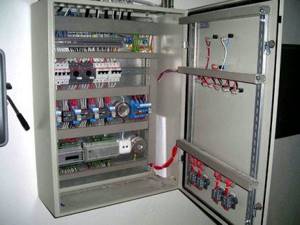
Modern control units are manufactured taking into account the possibility of saving energy. Let’s assume that properly selected automatic devices can reduce costs by 50-65%
The content and functionality of the shields may vary. For example, some systems require a frequency converter, while others do without it. The most convenient for use are cabinets and panels with automation and remote controls.
Work Item Overview
Structurally, the SHUV is a rectangular plastic or metal case with the required protection class IP 45. If operating conditions are associated with an increased risk, then the protection class is higher.
Inside the case there are devices such as a power supply, controller, and converters. Several circuit breakers are responsible for individual devices: air heaters, recuperators, fans, cooling units, etc.
A mandatory element is a manual control panel. An alarm unit is also required, which is triggered in an emergency and produces warnings with light or sound signals.

Strips and terminal blocks for installing electrical devices and connecting them with wires look the same as analogues for electrical distribution boards
Control elements also include sensors. These are a kind of receptors that collect various information about the state of the system and its environment.
They measure the temperature of the air and the devices themselves, the degree of concentration of gases or contamination of system elements, measure the speed of air movement, etc. The data obtained is sent to automatic regulators, and the operation of the system elements is adjusted.
Based on their functions, sensors are divided into the following types:
- temperature;
- humidity;
- speed;
- pressure, etc.
Temperatures can be either digital or analogue. A signal about a sharp increase or decrease in indoor temperature may cause the system to switch to another mode.
Humidity sensors operate on the same principle. The movement of air masses inside ventilation ducts can be determined using speed and pressure sensors. Based on their installation location, sensors are divided into internal and external. The first ones take data indoors, the second ones, which are also called atmospheric or street data, take data from outside buildings.
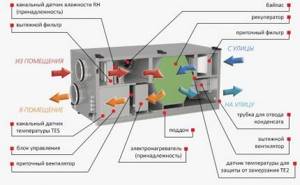
Ventilation sensors can also be ducted, that is, installed inside air ducts: either on the walls or across the air flow. They are universal and can transmit a large amount of information: temperature, pressure, air speed
Some sensors are fixed on the surface of parts that need to be monitored. They take parameters of the devices themselves, for example, winding temperature, rotation speed, etc.
The installation of sensors requires careful selection. On the one hand, the more information, the more accurately the system operates, but on the other hand, the operation and maintenance of the network becomes costly in terms of energy consumption.
Controllers work in conjunction with sensors. These are the devices that receive information and process it automatically. They can be called intermediaries, since the signal is then transmitted to actuators: air flow switches, fans, refrigeration units, heaters.
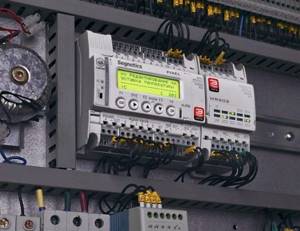
Controllers with microprocessors are more suitable for installation inside SHUV. They are compact in size and do not require a large area for installation
Particularly popular are universal type controllers, which are capable of simultaneously processing information coming from various systems: ventilation, heating, etc.
Recommendations for assembling SHUV
Installation and testing of control panels should be carried out by specialists with appropriate qualifications; independently installing and connecting elements inside a switchboard or cabinet is not only not recommended, but also prohibited.
The housings are not made by hand, but purchased ready-made or ordered taking into account the specifics of the ventilation system. A set of devices is supplied with the case: switches, controllers, power supplies, switches, protection elements and wires.
It often happens that the set of instruments and parts is not fully equipped - there are not enough wires or circuit breakers. When selecting spare parts, it is necessary to maintain compliance with the technical characteristics (for example, the cross-section of wires or the current strength of the machine).
Before ordering, you must make a list of all devices that are included in the ventilation system, as well as express your wishes regarding switching operating modes, the type of controller, and the presence of certain sensors. In some control panels, relays are installed instead of controllers.
An example of a ShchUV can be a sample with the following technical characteristics:
- nom. frequency – 50 Hz;
- voltage – 380 V;
- voltage of the connected fan – 220 V;
- engine power – 22 kW;
- protection level – IP65;
- dimensions – 400x800x180 mm;
- service life – 10 years.
Ready-made models are marked with symbols that contain information about the modification and its standard size, degree of protection, type of climatic modification, technical specifications or GOST number. In the latter case, manufacturers are guided by GOST 14254 and GOST 15150.
Automation functions and capabilities
The automation of the ventilation system performs several important tasks. Let's get to know them.
- Thanks to automation, the entire system works properly and is always under control. Usually a special accident analyzer is installed. Modern developments make it possible to control automatic systems remotely - the operator only monitors the operation of the existing device, and can also make his own adjustments by setting certain modes.
- Using automatic equipment, it is possible to analyze individually and monitor the functioning of each existing mechanism. In addition, it is possible to monitor the overall activity of the ventilation circuit. The unit’s sensors provide certain data, the automatic system examines the position and makes its own adjustments to the operation of the equipment. If an accident occurs, a corresponding shutdown signal is sent to a special start button.
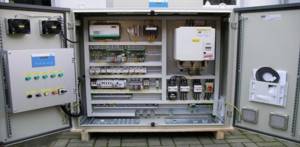
- Automation in ventilation systems is also designed to save valves and water heating circuits from the harmful effects of low temperature values. In addition, automatic equipment prevents the temperature from dropping to dangerous levels.
- The automatic control system allows you to regulate the ventilation in the room. Thanks to this addition, it is possible to switch various modes. Thus, in conditions of sudden changes in loads and temperatures, automation can reduce the rotation speed of existing fans, as well as deactivate the equipment completely.
- If there is such a nuisance as a short circuit or other similar problems, then the automation simply blocks certain mechanisms to prevent fire and electric shock to people.
As you can see, the automation that comes with the ventilation system performs many functions and allows you to avoid many serious problems. In addition, it is much easier to regulate ventilation with automatic components.
Sensors and Transducers
Sensors are elements of ventilation automation systems that serve to obtain information about the real state of the controlled object. With their help, feedback is provided between the control system and the object according to the following parameters: temperature, pressure, humidity, etc.
In order for information from the sensor to be transmitted to the system in the form of a digital code, each sensor is equipped with a converter.
The optimal locations for installing the sensors are indicated in the instructions supplied with them.
Temperature sensors can be for indoor or outdoor use; overhead on the pipeline (for monitoring the surface temperature of the pipeline) or duct (for measuring the air temperature in the air duct). Indoors, temperature sensors are installed in neutral places relative to sources of heat or cold, outside the building in places where the sensor will be protected from wind or direct sunlight.
Humidity sensors are a unit with an electronic device that measures relative humidity and converts the data into an electronic signal. There are external and internal versions. They are installed in places with stable humidity conditions; they are not allowed to be installed near heating radiators, air conditioning units, or near sources of moisture.
Pressure sensors are divided into pressure switches (mechanical measurement of differential pressure and electrical conversion) and analog pressure sensors (conversion of pressure directly into an electrical signal, for example, using piezo elements). Both are used to measure pressure at one point and the difference in pressure at two points.
It is advisable to install both external and internal sensors in twos or more, for example, on the north and south sides of the building. In modern systems, all external climate sensors are combined into a single weather station.
Flow sensors measure the speed of a liquid or gas in a pipeline or duct.
Liquid flow is calculated using a formula inside the processor unit based on the pressure difference and other parameters (temperature, pipeline cross-section, density).
Building an automated system
Construction of a fully automated ventilation system is one of the most important and labor-intensive processes. The quality of the subsequent operation of the control panel and, in fact, the ventilation system itself will depend on it. The most important point in this process is the selection of the necessary equipment, because both the required power and the expected performance should be taken into account.
Regarding power, it should be noted that its parameters should be taken into account in several variations:
- Power consumption of each device individually and the entire remote control as a whole.
- The power of air flow in ventilation ducts.
- Processor power.
The “processor power” parameter is the most important, since it characterizes the array of data that can be simultaneously processed by the system, the number of inputs and outputs in order to obtain information from sensors and send signals to the corresponding devices.
The main thing to remember is that in each individual case, the construction of the system must occur individually, taking into account the number of premises (buildings) covered, their architecture, existing devices, ventilation ducts, etc.
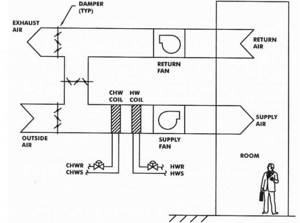
Regulators
Regulators are one of the main elements of an automation system for ventilation, providing control of actuators based on the readings of various sensors.
According to their functional purpose, these elements of ventilation systems are divided into speed regulators and temperature regulators.
Speed controllers can be single-phase or three-phase (just like motors). They also come with smooth or step control, and the choice of control method depends on the power of the fans. The most modern and economical method is to speed up the rotation of pumps and fans using frequency converters (FCs). Despite their high cost, inverters are economically justified even on motors with a power of more than 1 kW.
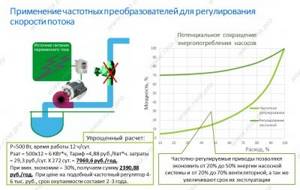
Temperature regulators, depending on the control method, are threshold ones, controlling the temperature using a fully open or fully closed damper (for example, a car thermostat), and with proportional differential control (PID), allowing smooth control of the temperature in the operating range.
Regulators in ventilation automation systems are controlled from control panels.
Conclusions and useful video on the topic
What the SHUV looks like when assembled, what is included in the “filling”, how the devices are mounted and the wires are connected, can be seen in the videos below.
Step-by-step assembly and installation options:
Video review - sample assembly of SHUV with heater:
Automation of a ventilation or any other system is a responsible and expensive process. If the equipment is selected or assembled incorrectly, an accident may occur resulting in people being injured, for example, at a chemical plant.
At a minimum, equipment, also expensive, will fail. For these reasons, the installation of control units from the initial design stage to the end should be carried out exclusively by specialists.
Please write comments in the block below. Share information that may be useful to site visitors. Ask questions, tell us about how you installed the ventilation system control panel with your own hands, and post photos related to the topic of the article.
Automation boards
The operation of the automated system, its convenience, reliability and safety of operation directly depend on the process control algorithms (specialists who performed the design and commissioning), as well as on the capabilities of the components. Algorithms are implemented at the software level and “hardwired” into freely programmable controllers installed in automation panels .
When connecting sensors to the automation panel, the type of signal transmitted by the converter (analog, discrete or threshold) is taken into account. Expansion modules that control device drives are selected in the same way.
Ventilation system panels can be power, control or combined if the system is small. Automation panels for ventilation provide:
- Turning the ventilation system on and off;
- Equipment status indication;
- Protection against incorrect connection of supply voltage and short circuit;
- Ventilation unit performance control;
- Indication of the status of air filters;
- Protection against overheating of electric motors;
- Protection of the air heater from freezing;
- Maintaining and controlling the air temperature at the inlet of the ventilation unit and in the room;
- Possibility of using temporary manual control algorithms.
System operating modes. Work in the building automation and dispatch system
The ventilation system automation panel must ensure operation in the following modes:
Manually . In this case, the system is controlled manually.
Automatic autonomous , with data transfer to the dispatch system. In this case, switching on and off occurs autonomously, without taking into account the readings of adjacent engineering systems, while notifications about the operation of the system are transmitted to the dispatcher.
Automatic as part of an automated building management system. In this mode, ventilation operation is synchronized with other life support systems of the building. All building systems, controlled by developed algorithms, form a building automation and dispatch system.
Sometimes, clever integrators present an automated autonomous system as fully automatic. The customer finds out about this when he starts receiving utility bills with amounts higher than expected.
The system is controlled using building management protocols. The most famous are LonWorks, ModBus, BACnet.
How to choose and install
When choosing control equipment for ventilation devices, special attention should be paid to the operational and technical characteristics.
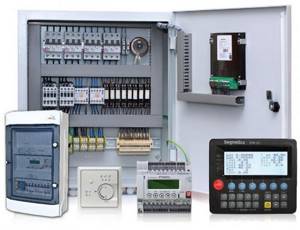
An important role in the correct selection of equipment is played by the complexity of the ventilation duct system, the number of rooms and their internal volumes, as well as the number of people in the room.
Preference should be given to products from companies that have proven themselves in the electronics market.
It is important to find out what the warranty obligations are and whether free service is provided. The higher the quality level of the equipment, the higher its cost. However, you should not spare money on high-quality equipment, since it will recoup all costs with many years of trouble-free service. The ideal option would be to find an electronic control module that combines build quality, a large number of functions and an affordable price. As practice shows, such equipment is now found among the products of new companies just entering the world market.
It is important! Installation and connection of ventilation automation systems should only be carried out by technicians with special approvals.
Specialists who have undergone the necessary training install the equipment in full compliance with the requirements of technical regulations.
When connecting independently, errors are possible that can lead to failure of both individual components and the entire equipment. Also, self-installed control systems are not subject to service, and in the event of a breakdown, the buyer will have to repair them at his own expense.
Conclusion
Installing an automatic ventilation system in a room may require certain knowledge and skills. This usually concerns the installation and connection of sensors and a control panel, on which its normal operation depends (see also the article “Automation for ventilation: functions, features, capabilities”).
The video in this article will help you find additional information on this topic.
Did you like the article? Subscribe to our Yandex.Zen channel
Installation of ventilation systems
Before installing ventilation systems with automatic components, proper design planning is required. To do this, you need to have certain engineering skills, so it is best to entrust such work to professionals.

Current technologies make it possible to design quite complex automatic control systems for ventilation systems. For this reason, their installation and subsequent commissioning, even with a well-designed project, should only be carried out by experienced specialists. It is not recommended to carry out such work with your own hands, especially if we are talking about a very complex scheme. Any shortcomings and errors made during installation can provoke a serious disruption of air exchange, which will result in conditions in the existing space that are impossible for people to stay in.
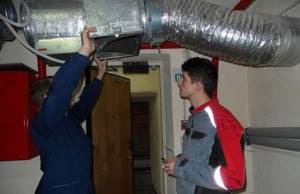
An equally important stage in carrying out such work will be commissioning. At this point, the operation of the assembled ventilation system as a whole is checked, and all the necessary indicators are provided in accordance with the project developed in advance.

As a result, proper operation of ventilation will contribute to the formation of a comfortable microclimate in the existing room or designated area. The use of modern technical devices provides many advantages, guaranteeing faster execution of the required commands.
Benefits of professional installation
According to the rules, the installation and maintenance of ventilation systems, as well as control units, must be carried out by specialists with an engineering education. They bear full responsibility for incorrect selection, installation, connection of devices, as well as for maintaining technical devices in improper or unsafe condition.
To correctly determine the contents of a panel or cabinet, installers do a full monitoring of the ventilation network. Then you need to do the following:
- analyze the load;
- choose the optimal scheme;
- determine the operating modes of devices in order to increase efficiency;
- select equipment.
The assembly itself takes a little time: all the devices are mounted one by one in several rows, the wires are carefully connected to the terminal blocks and laid along the lines in organized bundles, then taken out.
Professional installers have experience installing and operating control panels, so they are unlikely to make a mistake with the choice of model and the nuances of connecting devices. In addition, they are well versed in diagrams and can quickly identify if there is an error in a drawing.
If you don’t figure it out in time and connect the devices according to an illiterate diagram - and this also happens - you can create an emergency situation.
Setup and management
Newly installed ventilation systems must be properly configured. Of course, the correct distribution of air flows must be taken into account at the project development stage, when a number of required engineering calculations are carried out. However, in this case it is important to consider that:
- when designing, standard-type air duct sections are more often used, and the air itself can flow through them at different speeds;
- The lion's share of schemes have certain areas where it is possible to correctly distribute the air only manually.
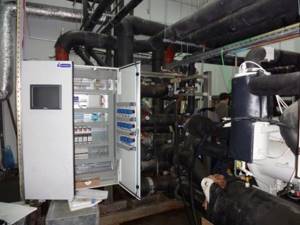
Taking into account these features, we can conclude that it is also better to entrust the installation of a ventilation system with automation to specialists. The procedure for carrying out this work is as follows:
- first, using an anemometer, the average speed of air passage through the ventilation grille is determined and calculated;
- then, using the value of the open cross-section of the grille, the volume of air is calculated based on a special formula;
- with the help of a control valve, the volume of air entering the grille decreases or increases;
- the air flow valve is built into both the air outlet and the grille;
- having changed the angle of the control valve flap, again carry out all the required measurements of the speed of air masses on the grilles;
- all identified parameters are checked against the project, and in case of discrepancies, the system is adjusted further.
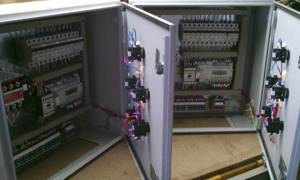
The main control capabilities of a properly installed ventilation system with automation are:
- sequential start;
- sequential stop;
- reservation and addition.
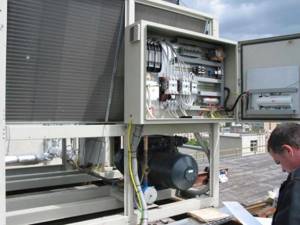
Equipment for automatic ventilation control system
A number of types of instruments, devices and sensors are produced to create automatic ventilation control. Control mechanisms are designed to control a separate process. But the devices not only control the entire process, but also control the operation of one section of the circuit.
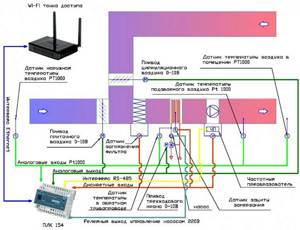
Automated supply ventilation control system
Therefore, automation includes dozens of different relays, sensors and other devices.
Important. As a rule, electronic devices are used to maintain ventilation. But to control the heating or cooling temperature of the air, a mechanical piping unit is installed.
The automatic ventilation system control device necessarily includes the following devices:
- air temperature regulator;
- fan speed control device;
- a water and air heating sensor is installed in the piping unit;
- shut-off valve control drive.
But these devices locally regulate the operation of the system or take measurements. Monitoring and determination of the overall level of safety, the entire operation cycle of the ventilation system, is carried out using the central control cabinet of the ventilation device.
The complexity of the system can be understood by reviewing the complete equipment list of this device. The number of specific sensors or relays can be significant, and some devices are presented in the singular. Let's look at the design of some automatic control panels.
Which power devices require circuit integrity monitoring.
All the cases discussed above are when the power circuits are not directly controlled: everything after the relay contacts is unknown.
But it happens when power actuators must operate during a fire, so the power circuits for their activation must be controlled - fortunately, there are few such devices.
Power actuators requiring circuit integrity monitoring:
1) reversible smoke exhaust and air pressure valves;
2) engines of fire pumps, valves and fans;
3 power electromagnetic (solenoid) fire extinguishing valves;
4) control cabinets for curtains or transoms.
Construction of a ventilation panel for a system with the installation of an electric heater
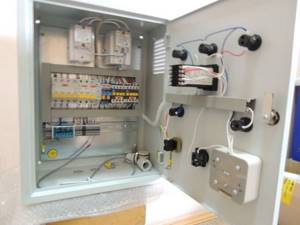
Supply ventilation control panel with electric heater
To set up this switchboard, the following automation components are used:
- temperature control regulator (one of the best options would be to use Swedish parts from Regin);
- control group for fans of the supply and exhaust system. The best option is to install devices that provide stepwise or smooth adjustment;
- ventilation unit usage indicators;
- a group of devices to maintain the nominal temperature in the room;
- turning off the electricity supply to the heater when the supply fans are turned off;
- a group of devices for shutting down and indicating air filter contamination;
- protective shutdown device when the system overheats;
- automatic shutdown system for peak short circuit currents and significant overloads.
